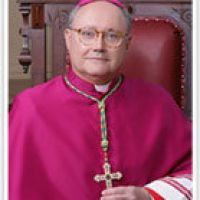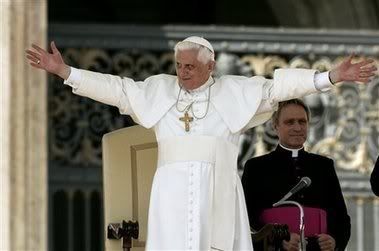I cannot say enough about the Holy Father's words that he said today at the Wednesday Audience. I am blown away how these talks on the Church Fathers are just getting better and better. If one wanted a intro to Church Fathers, The Trinity, and Catholic Tradition then this presentation by the Holy Father is magnificent place to start. He has put alot of important Catholic Patrimony into some very concise paragraphs here. Thanks to the Ratiznger forum for the translation and the above picture from today's audience.
Here is a translation of the Holy Father's catechesis today on St. Cyril of Alexandria:
Dear brothers and sisters!
Today, continuing our itinerary following the footsteps of the Fathers of the Church, we meet another great figure: St. Cyril of Alexandria. Linked to the Christologic controversy at the Council of Ephesus in 431, and the last outstanding representative of the Alexandrian tradition, Cyril was later defined by the Greek eastern church 'the custodian of exactitude' - in the sense of being custodian of the true faith - and even more concretely, 'the Fathers' seal of approval.'
These old expressions speak appropriately of a characteristic of Cyril - his constant reference to ecclesiastical authors before him (especially Athanasius) with the view of showing the continuity of his own theology with tradition. He placed himself deliberately, squarely and explicitly within the tradition of the Church, which is the guarantee of continuity with the Apostles and with Christ himself.
Venerated as a saint in both the eastern and western churches, Cyril was proclaimed a Doctor of the Church by Pope Leo XIII in 1882, at the same time as another important advocate of Greek patristics, St. Cyril of Jerusalem. This demonstrated the attention and love for Oriental Christian traditions of this Pope, who would also name yet another eastern figure, St. John Damascene, as Doctor of the Church, showing that the eastern and western traditions alike expressed the one Church of Christ. T
There is little information about Cyril's life before he was elected bishop of the important See of Alexandria. He was a nephew of Theophilus, who as Bishop starting in 385, guided the diocese with firmness and prestige. Cyril was probably born in Alexandria itself some time between 370 and 380. He was quickly drawn to the ecclesiastical life and received a good cultural and theological education. In 403, he was in Constantinople in the delegation of his powerful uncle, and participated in the Synod referred to as the Quercia, which deposed the Bishop of Constantinople (John Chrysostom).
This marked the triumph of the Alexandrian See over its traditional rival, that of Constantinople, where the Byzantine emperor lived. On the death of his uncle Theophilus, Cyril was elected his successor as Bishop of Alexandria in 412. He governed for 32 years with great energy, always zealous to establish its primacy in the East while keeping strong its traditional links with Rome.
In 417 or 418, the Bishop of Alexandria showed himself to be a realist when he resumed relations with Constantinople, broken in 406 after the deposition of the Chrysostom. But the rivalry with Constantinople flared again some ten years later, when in 428, Nestorius - an authoritative and severe monk from the Antioch school - was elected Bishop of Constantinople. Indeed, the new bishop soon drew opposition because he preferred to refer to Mary as the 'Mother of Christ' (Christotokos) instead of that which was already very dear to the people, "Mother of God' (Theotokos).
The reason for Nestorius's choice was his advocacy of Antiochean Christology which, in wishing to safeguard the importance of Christ's humanity, ended up by splitting it off from his divinity. Thus, if God and man were not united in Christ, then one could not speak of 'the Mother of God'. The reaction from Cyril - who was at the time the greatest advocate of Alexandrian Christology, which underscored the oneness of Christ's person - was almost immediate. From 429, he used every measure to reinforce this, including letters to Nestorius himself. In the second letter (PG 77,44-49) dated February 430, we read a clear statement about the duty of pastors to preserve the faith of the People of God.
This was his criterion, which is valid even today: the faith of the People of God is an expression of tradition, it is a guarantee of sound doctrine. So he wrote Nestorius: "We must expose the people to the teaching and interpretation of the faith in the most unimpeachable manner, and remember that he who would scandalize even just one among the 'little people' who believe in Christ will undergo intolerable punishment."
In the same letter to Nestorius - which, subsequently in 451, would be approved by the Council of Chalcedony, the fourth ecumenical council - Cyril wrote out his Christological faith clearly: "We affirm that two different natures are united in true oneness, but from both, come one Christ and Son, not because unity has eliminated the difference between his two natures, but rather because divinity and humanity, joined in inexpressible and unutterable union, have given us the one Lord and Christ and Son of God." This is important: that true humanity and true divinity were concretely united in one Person, our Lord Jesus Christ.
That is why, Cyril continued, "we profess one Christ and Lord, not in the sense that we adore the man together with the Logos - we cannot even imply the idea of separation by saying 'together' - but in the sense that we adore one and the same One, because his body is not extraneous to the Logos, it is the body which sits next to the Father, beside whom there are not two sons but only one who is united with his own flesh." Soon, the Bishop of Alexandria, thanks to wise alliances, succeeded in having Nestorius condemned repeatedly: first by the Roman See, then through a series of 12 anathemas composed by himself, and finally by the Council of Ephesus in 431, the third ecumenical council.
That assembly, which was marked by conflict and tumultuous conditions, ended with the first great triumph of Marian devotion and with the exile of the Bishop of Constantinople who refused to accept the title 'Mother of God' for the Virgin Mary, persisting in his erroneous Christology that brought division to Christ himself. After having prevailed over his rival and his doctrine, Cyril nevertheless, by 431, had wisely arrived at a theological formula of compromise and reconciliation with the Antiocheans. Even this is significant: on the one hand, the clarity of his faith, and on the other, an intense quest for unity and reconciliation within the Church.
In subsequent years, he dedicated himself in every way to defend and clarify his theological position up to the day he died on June 27, 444. Cyril's writings - truly numerous and already widely disseminated in Latin and Oriental translations during his lifetime, demonstrating their immediate success - are of primary importance for the history of Christianity. He wrote important comments on many books of the Old and New Testaments - among them, the entire Pentateuch (first five books of the Bible), Isaiah, Psalms and the Gospels of John and Luke.
His many doctrinal works - in which there is a recurrent defense of the Trinitarian doctrine against Arian and Nestorian theses - continue to be relevant. The basis of Cyril's teaching was ecclesiastical tradition, in particular, as I mentioned earlier, the writings of Athanasius, his great predecessor in the See of Alexandria. Among his other writings are the books
Against Julian, his last great response to anti-Christian polemics, dictated by him probably in the last years of his life as a reply to the work Against the Galileans that came out in 363, written by the emperor who was called the Apostate for having abandoned Christianity, the faith in which he had been educated. Christian faith is above all an encounter with Jesus, "a Person who gives a new horizon to life" (Deus caritas est, 1).
Of Jesus Christ, the incarnate Word of God, St. Cyril of Alexandria was a tireless and firm witness, underscoring above all his oneness, as he repeated in 433 in his first letter(PG 77,228-237) to Bishop Succensus: "The Son is One, the Lord Jesus Christ is one, before the Incarnation or after. The Logos born from God the Father is not different from the Jesus born of the Virgin Mary. Rather, we believe that He who was before time was also born through the flesh of a woman." This statement, beyond its doctrinal significance, shows that the faith in Jesus-Logos born from the Father then becomes well-rooted in history because, as St. Cyril writes, this same Jesus entered time by being born through Mary, the Theotokos, and will therefore be, as he promised, always with us.
This is important: God is eternal, he was born of a woman, and remains with us everyday. We live in this trust, and in this trust we find our way in life. Later, the Pope synthesized the catechesis in English: Dear Brothers and Sisters, The subject of today’s catechesis is Saint Cyril of Alexandria, known as the "pillar of faith" and the "seal of all the Fathers". He was born somewhere between 370 and 380, and at a young age became Bishop of Alexandria.
Cyril was a zealous defender of the faith. He took care to ensure that his theology was firmly situated within the tradition of the Church by referring to preceding ecclesiastical authorities, especially Athanasius. Through a series of letters countering the position of Nestorius, the Bishop of Constantinople, Cyril made a very significant contribution to Christology defending the divinity and humanity of Christ united in the one Lord, Christ and Son.
He was also of utmost influence at the Council of Ephesus, supporting the recognition of the Virgin Mary as the "Mother of God". This led to the deposition of Nestorius as Bishop of Constantinople. Saint Cyril, a prolific writer whose works were read throughout the Church, was declared a Doctor of the Church by Pope Leo XIII in 1882. May our remembrance of this outstanding figure in the history of Christianity remind us that the centre of our faith is the encounter with Jesus Christ, who gives each one of us a new horizon and a decisive direction!
I am pleased to welcome the English-speaking pilgrims present at this Audience, especially those from Australia, Denmark, Scotland and the United States. In a special way I greet the Maryknoll Missionaries, the priests from the Diocese of Wheeling–Charleston, the students from the Pontifical Beda College and Deacon Candidates from the Pontifical North American College. May God continue to strengthen you as you strive
















No comments:
Post a Comment